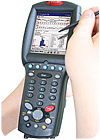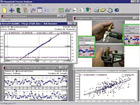
This mobile data collection device has a touch-screen interface. Source: I & R Partners
Japanese manufacturing quality culture has given us many useful concepts, including Kaizen, Kanban and Poka-yoke to name a few of the more well-known concepts. Another less familiar concept is Genchi Genbutsu, which loosely translates to “go to the actual spot and see for yourself.” In other words, instead of simply hearing or reading about a problem and then suggesting a solution, go to the site and form an opinion first-hand.
Maybe it is not too much of a stretch to think of this quality tool as encompassing the hot area of mobile data collection, in which process measurements are carried out in areas of the plant that auditors or inspectors could not otherwise access with their gages.
Paul Iannello, president of I & R Partners (Nashville, TN), a data collection products company, says, “The more remote and grimy places in the plant, as well as locations where parts are just too big to bring back to a central inspection area, are the ideal turf of mobile data collection devices. They allow auditors to rove from station to station, to see what’s going on, and address any problems that might be present there.”
Iannello says not every batch of statistical process control (SPC) data can be conveniently collected by a desktop PC. “Quality control data flow like that typically takes place in a factory locale close to a central processing point or in places where the environment is not as challenging.”
And now the marketplace is asking to go beyond mobile data acquisition to mobile data analysis. Iannello says this is the reason his company has recently allied with Mitutoyo America Corp. (Aurora, IL). The deal enables I & R’s remote data acquisition products to run Mitutoyo’s Pocket ML. This software is a scaled-down version of Mitutoyo’s MeasurLink, a suite of applications designed to analyze and manage quality and SPC data on an enterprise-wide basis. In turn, Mitutoyo will benefit from having its software carried around the plant in a rugged, industrialized line of mobile computers.
According to Iannello, any full-bore suite of SPC data analysis software is powerful in part because it has the benefit of a full-sized PC having multiple gigabytes of memory. However, a handheld unit is more limited in capability because it typically must make do with 64 to 128 MB.
Bob Brown, manager of Mitutoyo America’s MeasurLink Development Department, says, “Robust packaging is essential in a mobile data collection device. It must be highly ruggedized to withstand the industrial environment on the shop floor.”
Simplicity of the user interface on any mobile device is essential as well, and achieving it impacts both software engineering and ergonomic or human-factors design. Says Iannello, “User friendliness takes careful thought from both device designers and software folks. For example, we all worked hard to ensure that beginner skills required on our new handheld data collectors running Pocket ML were minimal. The touch-control interface was designed to be as simple as that on a Game Boy, while during any given measurement the built-in software provides an auditor with a line of instruction text about what to do next, and even affords an uploadable picture showing exactly where to make each measurement.”

A process analyzer is shown as a desktop application. Source: Mitutoyo
Mobile vs. Desktop Capabilities
According to Brown, it is challenging for a software designer to make a handheld mobile data collection system rich enough in functions to be useful to the auditor out on the shop floor. “For one thing,” he states, “you have to offer the user the appropriate QC graphics-the histogram, the run chart, the control charts-all the common QC statistics and process capability calculations, and the observation grid, among other features. Then you have to build in the ability to capture information such as traceability-to document the operator or shift number.”In addition, software must support the capture of assignable causes of variation, says Brown. “In other words, what caused an out-of-control condition and what is the associated corrective action?” Finally, the mobile computer software has to be able to capture the machine or device serial number.
“On the other hand,” says Brown, “any desktop QC software package can allow management to see and do more things, just by virtue of having more screen real estate to display information and by having access to peripherals such as printers, devices which don’t lend themselves functionally to the Windows Mobile operating system.” Brown adds that those in the market for a mobile data collection system should realize that a full desktop software package is necessary for more advanced functions, such as the ability to support multiple runs simultaneously, the ability to automatically e-mail an alarm of out-of-control condition, or 3-D graphical modeling.

Shown is the detail of a mobile display showing a Mitutoyo combined chart with individual and moving range, histogram and statistics. Source: Mitutoyo
The Power of Mobile
Observes Mitutoyo’s Brown, “The visualization available on the screen on mobile data collection devices gives you instant feedback on the SPC details of your production, right there at the inspection site. But in order for data collected by a mobile system to be printed and archived, it has to be streamed somehow back to a networked PC central station or other backend machine. When synchronized with a cable, or streaming wirelessly through a Web service using 802.11, as included with mobile computers, data is moved to the desktop. In general, mobility paired with wireless capability is powerful because it means acquiring data without having to synchronize it and upload through a wire. Instead, you collect it, and in real-time see it and send it to a database somewhere in the backend. That way everybody can view the result.”A prominent application for mobile data collection arises when a part is too large to bring back to the inspection center. With a mobile data collector the auditor essentially takes the inspection center to the part. A classic example might be climbing out on the wing of a Boeing 777 still under assembly to check rivet holes.
Near-term developments may soon see processing of mobile QC data acquisitions of a more unusual nature, such as photographic images of scratch defects on newly manufactured cars, for example, or perhaps a point-cloud data from some type of surface scan.
A photograph sent for storage and analysis to a backend machine running QC/SPC analysis and management software becomes associated with a collective file. If they need to, QC management can later drill down through a plot point on a control chart displayed on the PC at the back end to see the image or source data that gave rise to it.
When it comes to data collection, going to the source and forming a first-hand opinion is often the best option.Q
For more information on the companies mentioned in this article, visit their Web sites:
- I & R Partners, www.iandrpartners.com
Mitutoyo America, www.mitutoyo.com